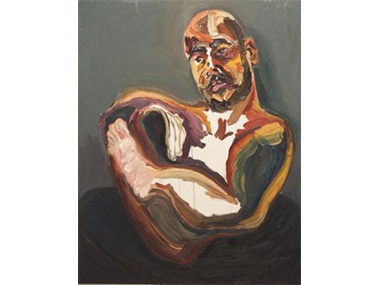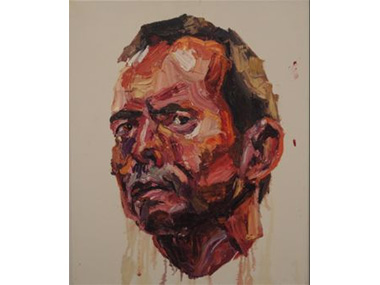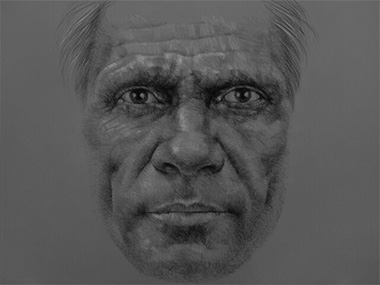ART & POLITICS

Myuran Sukumaran self-portrait from the 'Last 72 Hours' series (2015) - with suggestions of Ben Quilty's impasto and Francis Bacon's foreshortened legs
Posted by Jeremy Eccles | 12.01.17
Gallery: Campbelltown City Bicentennial Gallery
Dates:
12.01.17
: 26.03.17
Two major art exhibitions have opened in Sydney – one by a Western art-trained Aboriginal artist and one by an untrained Sri Lankan-born criminal – and both turn for their success or failure on politics.
For, of course, Myuran Sukumaran died from the bullets of an Indonesian government that just didn't have the courage to acknowledge he'd reformed from his drug-smuggling days and therefore deserved a pardon to carry on the obsession that had taken over his brief life – painting. Australia's government was also timid in the face of this implacability – though Sukumaran's series of friendly political portraits suggest his recognition that, behind the scenes, the likes of Foreign Minister, Julie Bishop were pushing diplomacy as far as it could go. Even the weak President Jokowi looks human.
But art was the key aspect of Sukumaran's transformation from the thuggish, heroin-addicted Enforcer of the nine youths dobbed in by the Federal Police to Indonesian authorities (do we yet know why?) to a man whose self-knowledge shines through the self-portraits now on show at Campbelltown Arts Centre – especially in the painfully knowing 'Final 72 Hours' series, literally painted as he faced the inevitable end. Hints of Francis Bacon's foreshortened bodies in a couple of them, anyone? As his art mentor and friend Ben Quilty – who is the most obvious influence on Sukumaran's style of painting, as would be expected from the fact that Myuran looked up “thick oil paint” art on Google and found Quilty as the pre-eminent exponent of the impasto technique – explained at today's opening, “When I was so furious with the rejection of Sukumaran's final appeal, I set up a #Boycott Bali site; only to be told by Myuran that no-one should blame the Balinese, 'I've brought it all on myself'.”
Six other artists – but not Quilty - pay tribute in their own way to Sukumaran's character and amazing artistic progress in just three and a half years of painting. But the politics continue at Campbelltown with 3 forums (starting this Saturday 14/1 at 1pm) considering the role of art in restorative justice. Taloi Havini's video work in the exhibition suggests how the same process operates on Bougainville.
Then, over at the National Art School (NAS) in Eastern Sydney, Brisbane's Vernon Ah Kee enjoys the largest show of his much longer life (50 years) to date. It reveals a brilliant drawer – using pencil and charcoal to great effect to capture the faces of his ascendants in blazingly outsize mode, and those involved in the Palm Island riots at a much more personal size. His latest work is a pair of outsize faceless figures with scarified bodies, hands tied behind their backs. The works are called 'Lynching I and II' and powerfully portray the depersonalising factor that might allow a mob to get out of control and lynch someone extra-legally – though I've never heard of it happening in Australia. There are also new surfboards playing on their shape's similarity to Rainforest shields from Ah Kee's original FNQ Country. He seemed keener to stress the quality of the actual boards than the meaning of the designs – justifying the technical upgrade on boards he's been painting for a decade.
But the key to a show called 'Not An Animal or a Plant' is its association with the 50th anniversary this year of the Referendum that counted Indigenous Australians at last amongst our citizens – making Ah Kee himself a non-citizen at his January 1967 birth. Nothing wrong with personalising in a good cause. But Ah Kee then goes over the top with his words to gild the lily:
"They (his ancestors) were photographed (by anthropologist Norman Tindale in the 1930s) because they were seen as a dying species," Ah Kee told the Sydney Morning Herald. "I wanted to humanise them. My grandfather was one of my heroes growing up and I wanted to monumentalise him. I wanted to make him big, as big as I thought he was."
Pride in one's grandfather is one thing. But traducing Norman Tindale's reputation without apparently knowing anything about it is another. For Tindale didn't just take photographs of a dying species (NB not a dying race) as Daisy Bates might have done, he took photos of individuals and, in the process, proved the continued existence of Tasmanian Aboriginal people, he established the discipline of tribal boundaries that denied the white foundation myth of Terra Nullius, he recorded detailed knowledge of Aboriginal traditions in both southern and northern Australia which today allows people to recover language, identify artefacts and their mode of manufacture, recreate ceremonies, and make land claims. He significantly pushed back the accepted date for the arrival of Aborigines in Australia. He opposed the Stolen Generations policy. He did, mistakenly believe that Southern mixed-race Aborigines would “disappear into the general community”, but he also recommended that tribal peoples be left to live under their own laws and lore for several generations.
This was not a man, as one critic of the show was mis-moved by Ah Kee's assertions to claim that Tindale was carrying out a project “of profound depersonalisation”.
Politics are a tricky beast to ride – just ask Kevin Rudd or Tony Abbott. Art that grows from a cause may develop its own validity. Art that has politics imposed upon it may lose face.
The Sydney Festival – of which both these exhibitions are part – is run by its first Indigenous Director, Wesley Enoch. But, he stresses, that doesn't make it an Indigenous festival – as Rhoda Roberts's memorable 1997 Festival of the Dreaming was. “That's not what Sydney's festival is, and the challenge for me is to help Indigenous artists make work of scale worthy of this festival – finding the resources and mindset, overcoming the fatal timidity of wondering, 'Will it fail?' Luckily I've got two more festivals. But I certainly wasn't going to miss out on two reflections about the Referendum – Vernon's art and the concert of gratitude on 17th January, 'Music in the Key of Yes'.”
Also selected as Aboriginal contributions to the festival are 'The Season' (to Sunday 15th at the Opera House), 'Which Way Home' (to 29th Jan at Belvoir) and 'Blood on the Dance Floor' (21/25th at Carriageworks) – all existing shows unseen in Sydney, and all will be reviewed on this site. “There's less celebration, more questioning in them”, explained Enoch; “we're capable of complex ideas, you know. Over-simplification of issues is a disservice” - as long as it's Indigenous people doing the questioning. “Other people can't define who we are”.
Which does raise the tricky question, “To what extent, then, can Vernon Ah Kee define (and dismiss) who remote Aborigines are?” - as he all-too-often does in order to prove that he's not what he calls an “Ooga-Booga”. Surely his art does that for him?
URL: http://www.sydneyfestival.org.au/2017/all
Share this:
»  del.icio.us
»
del.icio.us
»  Digg it
»
Digg it
»  reddit
»
reddit
»  Google
»
Google
»  StumbleUpon
»
StumbleUpon
»  Technorati
»
Technorati
»  Facebook
Facebook
Contact Details
Gallery: Campbelltown City Bicentennial Gallery
Contact: Michael Hedger- Director
Email: art.gallery@campbelltown.nsw.gov.au
Telephone: +61 2 4645 4335
Address: Art Gallery Road Campbelltown Campbelltown 2560 NSW
Gallery: Campbelltown City Bicentennial Gallery
Contact: Michael Hedger- Director
Email: art.gallery@campbelltown.nsw.gov.au
Telephone: +61 2 4645 4335
Address: Art Gallery Road Campbelltown Campbelltown 2560 NSW

A pensive ex-Prime Minister Tony Abbott from Myuran Sukumaran's 'Political Portraits' series (2014)

Vernon Ah Kee's "monumentalised" 'Grandfather George' Sibley (2008), acrylic, charcoal and crayon on canvas 180 x 240 cms.
Where is the exhibition?
Further Research
Gallery: Campbelltown City Bicentennial Gallery
Artists: Vernon Ah Kee
News Tags: Ben Quilty | Campbelltown Arts Centre | Jeremy Eccles | Myuran Sukumaran | National Art School | Norman Tindale | Sydney Festival | Vernon Ah Kee | Wesley Enoch
News Categories: Australia | Blog | Event | Exhibition | Feature | Festival | Industry | News
Exhibition Archive
- 03.09.18 | Mawurndjul Makes Headlines in DC
- 23.08.18 | Indigenous Pots Are Hot
- 19.08.18 | CIAF Sets Records
- 16.08.18 | The Politics of Art in Darwin
- 01.08.18 | A SENSE OF PLACE
- 29.06.18 | INTERNATIONAL ACTIVITY
- 24.06.18 | Blak Markets Back in Sydney
- 22.06.18 | “I am the old and the new”
- 08.06.18 | WARS & MASSACRES
- 03.06.18 | NY “Goes Ballistic” over Aboriginal Art
- 24.05.18 | THE LOCKHART BRAND IS BUOYED UP
- 03.05.18 | THE WYNNE'S A WINNER AGAIN
- 02.05.18 | NATSIAA FINALISTS ANNOUNCED
- 07.04.18 | ENGLAND'S EMILY?
- 04.04.18 | THE SONGKEEPERS
Advertising

